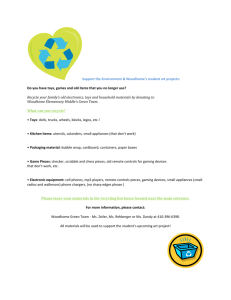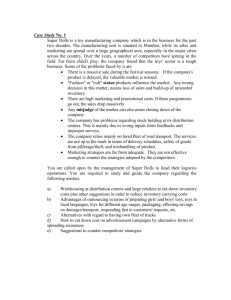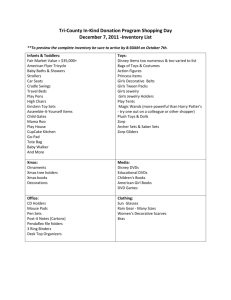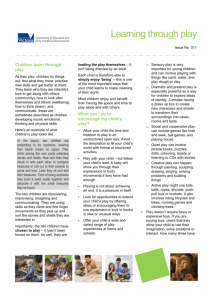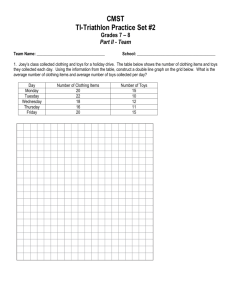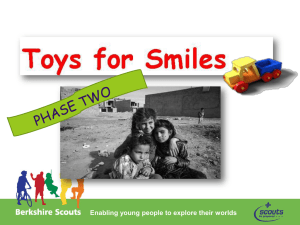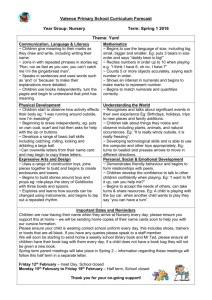review answers - Gilbert Public Schools
advertisement
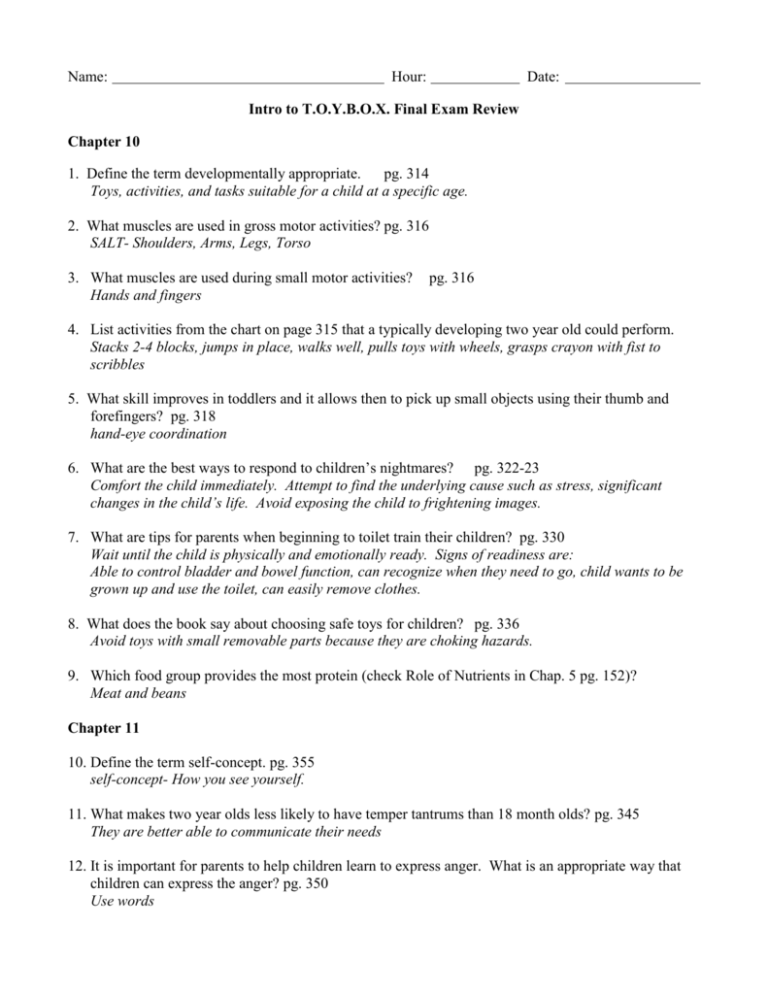
Name: Hour: Date: Intro to T.O.Y.B.O.X. Final Exam Review Chapter 10 1. Define the term developmentally appropriate. pg. 314 Toys, activities, and tasks suitable for a child at a specific age. 2. What muscles are used in gross motor activities? pg. 316 SALT- Shoulders, Arms, Legs, Torso 3. What muscles are used during small motor activities? Hands and fingers pg. 316 4. List activities from the chart on page 315 that a typically developing two year old could perform. Stacks 2-4 blocks, jumps in place, walks well, pulls toys with wheels, grasps crayon with fist to scribbles 5. What skill improves in toddlers and it allows then to pick up small objects using their thumb and forefingers? pg. 318 hand-eye coordination 6. What are the best ways to respond to children’s nightmares? pg. 322-23 Comfort the child immediately. Attempt to find the underlying cause such as stress, significant changes in the child’s life. Avoid exposing the child to frightening images. 7. What are tips for parents when beginning to toilet train their children? pg. 330 Wait until the child is physically and emotionally ready. Signs of readiness are: Able to control bladder and bowel function, can recognize when they need to go, child wants to be grown up and use the toilet, can easily remove clothes. 8. What does the book say about choosing safe toys for children? pg. 336 Avoid toys with small removable parts because they are choking hazards. 9. Which food group provides the most protein (check Role of Nutrients in Chap. 5 pg. 152)? Meat and beans Chapter 11 10. Define the term self-concept. pg. 355 self-concept- How you see yourself. 11. What makes two year olds less likely to have temper tantrums than 18 month olds? pg. 345 They are better able to communicate their needs 12. It is important for parents to help children learn to express anger. What is an appropriate way that children can express the anger? pg. 350 Use words 13. What are some common emotions felt by child when a new sibling enters the family? pg. 352 Jealousy, resentment, anger 14. Guidance from parents helps teach: pg. 368 a. self-discipline b. moral development b. develop a conscience 15. Define the term autonomy. pg. 371 autonomy-Independence Chapter 12 16. Describe the different methods of learning. pg. 382 Incidental- unplanned learning Trial and Error- when several solutions are tried before finding the one that works Imitation- learning by watching and copying Directed- learning that results from being taught 17. What area of intellectual development is required for playing games that involve problem solving and strategy? pg. 387 reasoning 18. Define perception. pg.387 Perception- Information received through the senses 19. Define articulation. pg. 400 Articulation- the ability to use clear distinct speech Chapter 13 20. A complete set of permanent teeth contains how many teeth? pg. 410 32 21. How should parents handle thumbs sucking in preschool age children? pg. 410 Ignore it 22. Children who are obese are more likely to: pg. 420 a. be overweight as an adult b. increase risk of heart disease c. increase risk of diabetes 23. What happens when more calories are eaten than a child burns through physical activities? pg. 420 The child gains weight because the extra weight is stored as fat. 24. What may cause a 4 to 6 year old child who is potty trained to have accidents? Pg. 424 Stress from new situations such as starting school Chapter 14 25. What are common responses children have to stress? pg. 435 Headaches, stomach aches, sleeping difficulties 26. How does empathy alter a 5 year old child’s behavior? pg. 431 Makes them more likely to cooperate with other children 27. What are appropriate ways for adults to respond to a child’s fears? pg. 434 a. accept the fear b. let the child express the fear without ridicule c. help the child believe they can face the fear 28. Why is a time out appropriate if a child’s behavior is out of control? pg. 433 It allows the child time to calm down 29. When encouraging children, Erik Erikson believed allowing them to make their own decision is important because it helps the child gain self-confidence . pg. 436 30. What is the best way to teach moral behavior to children? pg. 444 Model the desired behaviors 31. What are some negative aspects of competition? pg. 443 a. instills the idea that success depends on the ability to outdo others b. may lead to hostile relationships c. discourages initiative in those that rarely win d. lowers status and self-esteem 32. What are some positive aspects of competition? pg. 442 a. stimulates individual efforts b. helps gain realistic view of their own abilities c. helps children excel d. prepares them for the adult world Chapter 15 33. Describe the traits of each different type of multiple intelligences. pg. 455-456 Linguistic: involves sensitivity to and the ability to learn languages Logical-mathematical: ability to analyze problems and use logic, solve mathematical problems and explore issues scientifically Spatial: involves understanding of the potential use of space, thinking in 3-deminsional terms Musical: skill in performing, composing, and appreciating musical patterns Bodily Kinesthetic: potential to use one’s body to solve problems, using the mind to coordinate body movements Interpersonal: potential to understand the intentions, desires, and motivations of others. Intrapersonal: entails the capacity to understand oneself. Naturalistic: recognizing, categorizing, and drawing upon the features of the environment 34. What does it mean if a child has an egocentric view point? pg. 458 Viewing the world in terms of one’s own understanding, thoughts, and feelings. 35. What is alliteration? pg. 463 Repetition of certain sounds 36. How does art contribute to a child’s development? Pg. 464 a. Helps develop fine motor skills b. encourages creativity c. helps express their feelings 37. What is an important personal need children should manage before starting Kindergarten? pg. 467 Going to the bathroom without help 38. How can parents help children feel more comfortable when starting school? pg. 468 a. arrange playdates with future classmates b. allowing the child to pick out their own lunch box or backpack c. visit the school together before the first day d. share positive feelings about school with the child Chapter 21 39. What does the term regression mean? Give some examples. pg. 599 The backward movement to an earlier stage of development a. toilet trained children having accidents b. sucking thumb after previously having stopped the behavior c. a weaned child wanting to use a bottle 40. What is a mandated reporter? pg. 620 Individuals who are required by law to report maltreatment if evidence of it is seen. 41. Define the types of abuse/maltreatment: pg. 617 Emotional or verbal- rejecting children, blaming them or constantly scolding them, particularly for reasons beyond their control Physical- intentionally causing an injury to a child. Sexual- any inappropriate sexual behavior with a child including toughing or taking photographs Neglect- failure to provide for a child’s basic needs including food, clothing, shelter, love and attention. It can be both physical and emotional. Chapter 22 42. What is a daily schedule? pg. 647 The plan for how children will spend their time in the early childhood classroom. 43. What are transitions and why are they important for children in an early childhood setting? pg. 646 Transitions are periods when children move from one activity to the next. They allow children to finish up one activity and prepare for the next one. 44. What is positive reinforcement? pg. 650 Recognizing and rewarding desired behaviors.



